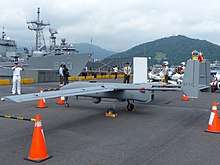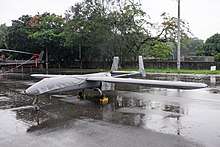NCSIST Albatross
The Albatross, also known as the Chung Shyang II, is a medium unmanned aerial vehicle made by National Chung-Shan Institute of Science and Technology.[1] It is in service with the Republic of China Navy.
| NCSIST Albatross | |
|---|---|
 | |
| NCSIST Albatross, then called the Chung Shyang II UAV, being unveiled publicly on the 2007 National Day Celebrations | |
| Role | UAV |
| Manufacturer | National Chung-Shan Institute of Science and Technology |
| Introduction | 2007 |
| Status | In service |
| Primary user | Republic of China Navy |
| Number built | >32 |
| Unit cost |
~3 million USD |
| Developed from | Chung Shyang I |




Description
The Chung Shyang II UAV can perform surveillance, reconnaissance, target acquisition, artillery spotting and battle damage assessment sorties for the military and perform other duties such as border patrol, and aerial reconnaissance for various government agencies.[2]
The Albatross has a wingspan of 8 meters[3] and a range of more than 180km. Endurance is approximately 12 hours.[4] It carries an electro-optical payload and can operate in both day and night. In addition to its military capabilities the Albatross can also be used for civilian applications such as agriculture, fisheries, animal husbandry, disaster monitoring, environmental protection, traffic control, target searching, position recognition, coastal patrol, communications relay, and hazardous terrain survey.[5] Officials have refused to comment on whether the type can be armed.[6]
Development
CSIST unveiled a prototype of the UAV at the Taipei Aerospace & Defense Technology Exhibition in August, 2005. CSIST began researching UAVs in 2002, which resulted in the first Chung Shyang I UAV, then later the Chung Shyang II.[7]
Service history
In 2017 the drones were transferred from the Army Aviation and Special Forces Command to the Naval Fleet Command.[8]
In 2019 a Navy Albatross made the types first fly-over demonstration during an exercise in Pingtung.[4]
Following a 2019 crash the military ordered upgrades to be made across the entire Albatross fleet,[9] by May 2020 NCSIST had completed upgrades on 26 aircraft.[8]
Incidents
Albatross' have crashed in 2012, 2013, and 2016.[10]
On Jan. 24 2018, an Albatross crashed into the sea during a military exercise off of Taitung. Mechanical failure is suspected to be the cause of the crash.[4]
Operators
- Republic of China Army- former operator,[8] 32 in service in 2014[2]
- Republic of China Navy- >26[8]
Specifications
Data from Taiwan News[8]
General characteristics
- Length: 5.3 m (17 ft 5 in)
- Wingspan: 8.6 m (28 ft 3 in)
- Gross weight: 317 kg (699 lb)
Performance
- Range: 180 km (110 mi, 97 nmi)
- Endurance: 12 hours
- Service ceiling: 4,000 m (13,000 ft)
See also
References
- Ng, JR (August 2019). "Asia-Pacific Unmanned Aerial Vehicle Directory 2018". Asia Military Review: 14–27. Retrieved 17 January 2020.
- Keck, Zachary. "Taiwan's Using Drones to Spy on China". thediplomat.com. The Diplomat. Retrieved 17 July 2019.
- Elaine Hou and Kuo Chung-han, Rita Cheng. "New U.S. drone sale policy could be good for Taiwan". focustaiwan.tw. Focus Taiwan. Retrieved 17 January 2020.
- and Evelyn Kao, Wang Cheng-chung. "Albatross drone makes first fly-over demonstration in Pingtung". focustaiwan.tw. Focus Taiwan. Retrieved 17 January 2020.
- "Albatross Tactical Unmanned Aircraft Systems". www.ncsist.org.tw. NCSIST. Retrieved 17 January 2020.
- Peck, Michael (2017-08-08). "Taiwan shows off UAVs". www.c4isrnet.com. C4ISR.net. Retrieved 17 January 2020.
- SOBIE, BRENDAN. "Government-controlled CSIST unveils Chung Shyang II mock-up and hopes to develop strike version for military". www.flightglobal.com. Flight Global. Retrieved 17 July 2019.
- Chen, Kelvin. "Taiwan's Navy upgrades drone fleet". www.taiwannews.com.tw. Taiwan News. Retrieved 18 May 2020.
- "Taiwan upgrades Albatross tactical UAVs". www.janes.com. Janes. Retrieved 23 May 2020.
- Yeh, Joseph (2016-10-28). "Military UAV goes missing during training exercise: Taiwanese Army". www.asianews.eu. Asia News. Retrieved 17 July 2019.
